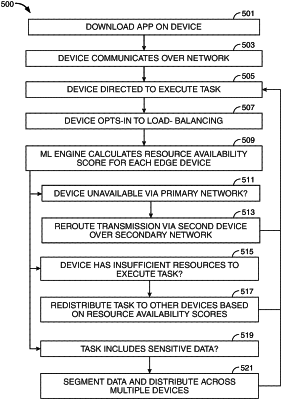| CPC H04L 47/783 (2013.01) [H04L 47/762 (2013.01); H04L 47/823 (2013.01)] | 20 Claims |

|
1. A machine-learning (ML)-based digital communication system with maximized resource utilization, the system comprising:
a central server comprising a processor and a non-transitory memory storing computer executable instructions that, when run on the processor, are configured to cause the processor to transmit communications over a communication network;
a plurality of edge devices, wherein the plurality of edge devices are located at a logical edge of the communication network and communicate with each other and with the central server via the communication network; and
a machine-learning (ML) engine; wherein:
the central server is operated by an entity that is independent of the communication network;
the plurality of edge devices each comprise an authenticated software application that is provided by the entity; and
when a first one of the plurality of edge devices is directed to execute a task:
the ML engine calculates, for each of the plurality of edge devices, a predicted resource availability score, wherein the predicted resource availability score is reduced based on a future task scheduled to be performed on a device; and
the central server distributes the task among the plurality of edge devices based on the predicted resource availability score.
|